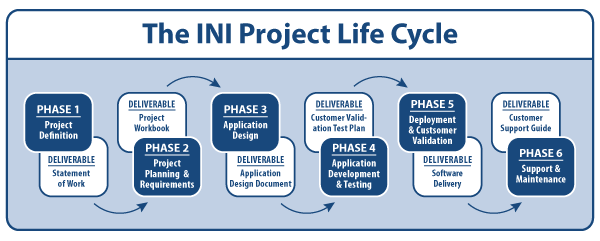Our Project Life Cycle process for application development maximizes customer satisfaction. Our process ensures that INI delivers quality products and services that meet or beat expectations. Here’s how it works:
Phase 1: Project Definition
A team consisting of INI sales consultants and sales engineers spend time understanding the client’s particular needs and requirements. The team reviews them and presents a solution recommendation in a Statement of Work (SOW) document. The SOW serves multiple purposes:
• Lists the goals of the project
• Outlines the application requirements and features
• Establishes the project scope and pricing
Phase 2: Process Planning & Requirement Analysis
A project team including customer representatives, the INI project manager and other project stakeholders meet to accomplish the following:
• Identify key project team members and roles and responsibilities
• Discuss project milestones, timelines and deployment approach
• Establish a plan for escalating issues
• Assess project risks and formulate a mitigation strategy
• Review high-level application requirements documented in the SOW
• Begin customer validation test planning
• Double-check and gather the exact functional requirements
• Create a communication plan to keep all team members informed and engaged
From these meetings the INI project manager will prepare a project workbook that helps set and manage expectations, and ensures everyone understands the project scope.
Phase 3: Application Design
The INI design engineer, INI project manager and customer work together to refine the project’s functional requirements. Then the project manager delivers them in an application design document, which includes the user interface scripts and/or flowcharts, data flow diagrams, data dictionaries, and screen and data extract mock-ups necessary to fully document customer requirements.
Phase 4: Application Development & Testing
After you accept the application design document, INI developers follow the document with exactness. As development progresses, INI’s quality assurance (QA) team begins continuous, methodical, software component testing. Once the software has successfully passed all QA tests, the INI project manager distributes a customer validation test plan to aid the end-user team in validation testing.
Phase 5: Deployment & Customer Validation Testing
Upon QA release, INI delivers the application. The INI project manager performs the installations at onsite, typically during the workday. The project manager also provides application administration training at this time. Your organization then performs validation testing to identify any areas where the application may not perform according to the application design document. In a timely manner, a customer can report any issues to the INI project manager who will coordinate fixes and/or changes with the INI development team.
Phase 6: Support & Maintenance
Upon receipt of the project completion form, the INI project manager, INI customer support representative, and customer representatives participate in a review meeting wherein the INI project manager presents a customer support guide. This document assists in maintaining your software and contains information such as:
• Back-up plan
• System maintenance tips
• Contact information for support
• Application enhancement process

